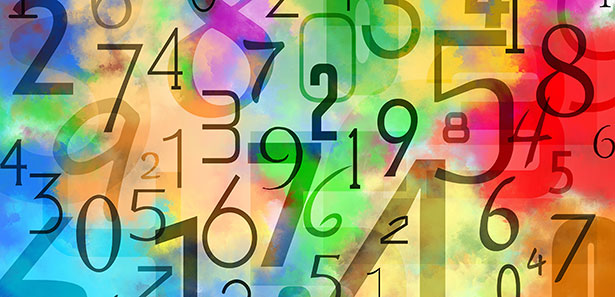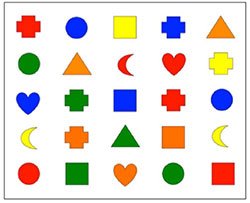Hypnosis produces synaesthesia
Suggestions under hypnosis lead to altered color perception
Manipulated perception: Hypnosis can trigger a synaesthesia-like combination of colors and forms - at least in some people. Thus, they no longer see certain symbols in their real color, but in the hypnotized way in which they were previously suggested, as an experiment proves. This manipulated perception of color resembles congenital synaesthesia in some aspects - but not in all, as the researchers emphasize.

In people with synaesthesia, several sensory impressions are linked - for example, numbers or letters with certain colors. © lukbar/ thinkstockFor people with synaesthesia, the impressions of different senses are not separated, but merge with each other. For example, they see numbers and letters in certain colors or "smell" music. What triggers this innate ability to "hear the colors" or "taste the words" is still mysterious to this day. However, there are first indications that genes are at least partly responsible. Anomalous strong connections between different areas of the brain are also discussed as causes.
Suggestion in hypnosis
Now Sakari Kallio and his colleagues from the University of Turku have found out that at least a very similar perception of synaesthesia can be produced by hypnosis - at least in some people. For their study, the researchers put four hypnotizable and four hardly susceptible test persons into hypnosis.
During this trance-like state, they showed the participants three different geometric shapes - circles, crosses and squares - suggesting that each shape always appears in a certain color. Then the participants were awakened and took a seemingly simple test: they were asked to indicate as quickly as possible the color of the symbols displayed one after the other on a screen. All test subjects had already carried out this test before the hypnosis session.
Red instead of blue
It turned out:
Three of the four strongly hypnotizable subjects showed a strong synaesthesia-like connection between form and color, reports Kallio.
Although, for example, the seen circle was actually blue, they called it red - the color suggested in the hypnosis. In some cases this happened without the subjects being aware of the previous suggestion.

If the suggestion takes hold, the test subjects would have to see these squares, crosses and circles in the same suggested color. © Kallio et al. /Scientific Reports
These participants also responded with a delay - another indication that there were conflicts between the real perception and the hypnotized perception suggested earlier, as the researchers explain. In contrast, these effects did not occur in the hardly hypnotizable subjects and a control group that had previously trained a certain color-form assignment without hypnosis did not show this reaction.
Similar to synaesthesia but not the same
Our results clearly show that hypnotic suggestions can produce a condition similar to synaesthesia, according to the researchers.
Anomalous brain connections are therefore not a prerequisite for such perceptual phenomena.
This also confirms previous studies that show that hypnosis can even trigger visual hallucinations in susceptible individuals, says Kallio.
However: Despite all similarities to the real, inborn synaesthesia, there were also clear differences. Although synaesthetes associate a color with certain symbols, this does not completely cover the real color.
Our subjects reported that the object had the suggested color, but people with grapheme-color synaesthesia typically see the color somewhere above the symbol, the researchers said.
Insights into our consciousness
According to Kallio and his colleagues, this suggests that the neurological mechanism behind congenital synaesthesia and hypnosis-induced synaesthesia is not the same.
Nevertheless, it is likely that they share certain neurological traits, said the researchers.
Therefore, further research into hypnosis-induced synaesthesia and hallucinations could certainly help to solve the mystery of "color hearing".
We could also learn more about other mechanisms of our perception:
Exploring such experiences improves our understanding of perception, attention and automation of neurological processes, explains Kallio and his colleagues. This opens up unique opportunities for cognitive neuroscience and consciousness research.
Source: Scientific Reports; doi: 10.1038/s41598-017-16174-y

Great post @n3bul4! Thanks for sharing
You are welcome!
This post has received gratitude of 1.00 % from @jout
Thanks!
well written and informative article.
Thank you! It's my pleasure!
amazing scientific knowledge you gather its great and amazing...
after long time glad to see you post with amazing knowledge of science and studies always admire it and like it keep it up bro ☺
Congratulations! This post has been upvoted from the communal account, @minnowsupport, by n3bul4 from the Minnow Support Project. It's a witness project run by aggroed, ausbitbank, teamsteem, theprophet0, someguy123, neoxian, followbtcnews/crimsonclad, and netuoso. The goal is to help Steemit grow by supporting Minnows and creating a social network. Please find us in the Peace, Abundance, and Liberty Network (PALnet) Discord Channel. It's a completely public and open space to all members of the Steemit community who voluntarily choose to be there.
If you would like to delegate to the Minnow Support Project you can do so by clicking on the following links: 50SP, 100SP, 250SP, 500SP, 1000SP, 5000SP. Be sure to leave at least 50SP undelegated on your account.
This post has received a 2.18 % upvote from @booster thanks to: @n3bul4.